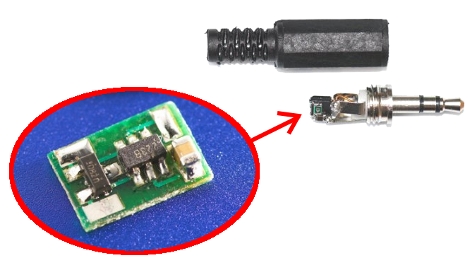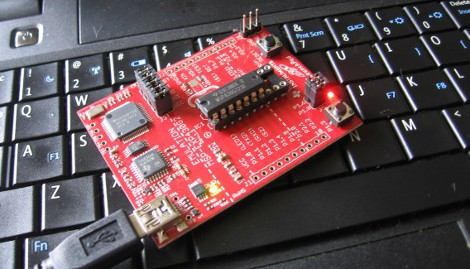When TI released their Launchpad development board at the end of June it generated a lot of Buzz. Here’s a package that delivered a programmer, debugger, two microcontrollers, and some accessories for less than five bucks (including shipping). They even provided a choice of two software suites but only for users running Windows who don’t mind proprietary software. If you’re looking to go another way you should consider trying out the open source alternative MSPGCC. After the break we’ll take a look at getting the tool-chain up and running in a Linux environment.
Author: Mike Szczys6403 Articles
MSP430 Based Single LED Clock

[Kenneth Finnegan’s] latest clock makes use of the TI Launchpad for programming and debugging MSP430 microprocessors. We took a look at the Launchpad when it was released and we’re glad to see some hacks resulting from availability of that tool. The clock reads out the time using a bi-color LED. Press the button and a series of flashes will tell you the time. A three-position toggle switch is used along with the push button for setting the time. The protocol he developed is outlined in his demo video after the break.
We like [Kenneth’s] use of a plastic electrical box as a project box. They’re cheap and you can find them everywhere in many different sizes. He mentions the difficulty in drilling through the faceplate. We’ve had our share of shattered plastic trying to drill holes in the darn things. If you’ve got some tips on faceplate-modification we’d love to hear them.
This clock is sure the polar opposite from the TTL clock that [Kenneth] showed us back in March, trading jumper wires for lines of code. We’re going to give this one a try, hopefully fixing the button debounce along the way.
Snapping Pics At The Right Moment With A Pressure Plate

[BiOzZ] built a pressure sensitive camera accessory to snap pictures at just the right moment. Before turning out all the lights the camera is set up with a twenty-second timer and a three-second exposure. The pressure plate doesn’t take the photo, but fires the flash to catch an image in the middle of the action.
The hack uses a piece of acrylic as the base of the pressure plate. A switch is constructed by placing aluminum tape on the base, and attaching a thin metal strip that is bent to add just a bit of spring. When an object is place on the plate the thin metal contacts the aluminum tape completing the circuit, a change in the weight breaks it. A simple circuit connects to this, using a relay to actuate the flash from a disposable camera. This is perfect for documenting the moment when you exercise that fruit-induced rage that has been consuming you lately.
Road Tour On A Bike With An Attitude

This is Precious. Precious is a bike that the folks over at BreakfastNY have anthropomorphised for a good cause. By adding sensors for a variety of data sources to the bike, and transmitting them back to a server via a cellular module, Precious can spit out cheeky comments about the ride on its Twitter feed. Right now Precious is on his way across the country powered by his rider, Janeen, to raise money and awareness for cancer research. You can track the progress, enjoying some attractive web design and reading the oft-beligerant comments from the bike, at yesiamprecious.com.
Although there’s no specifics about the hardware, we saw the typical project box during the teaser video. Inside you’re sure to find the usual suspects. Considering that speed, cadence, grade, temperature, humidity, and GPS data are all available on high-end bike computers we hope they found a way to just read in that data. But your guess is as good as ours; start speculating in the comments.
Open Graphing Calculator: Beagleboard + R

It looks like we missed the boat on this one but just in case you missed it everywhere else on the Internet, last Saturday [Matt Stack] introduced the world to a completely open source calculator. This marries two heartily tested open source projects; the R Project for Statistical Computing and the Beagleboard. The hardware side of things is very similar to that Linux tablet from back in June. It uses a stock Beagleboard with the BeagleTouch module.
Why do we care? First off, don’t forget what’s under the hood. That ARM processor kicks the 6 MHz Z80 processor found in TI’s calculators to the curb. The R language is a boon as well, offering plots of almost limitless quality and allowing extensibility that can’t be equaled with the current non-open offerings. But mostly because it’s a hack. We like seeing software run on hardware it wasn’t intended for.
Miniscule Intervalometer

Calling this intervalomemter small would be a glaring understatement. It’s tiny enough to fit inside the plastic cover for a 2.5mm jack for use with a Canon DSLR camera. We should point out that the image we put together is a bit misleading. The picture of the jack is version 1 of this circuit and uses an 8-pin SOIC chip. The board in the oval is version 2, with a PIC 10f222 SOT23-6 package making it even smaller than the original version.
This is used for time-lapse photography. When plugged in the chip draws power from the camera. Get this: it learns the timing interval by listening for the first two images. Once you’ve snapped the first two pictures the PIC will continue to take images based on that initial delay. Amazing.
[Thanks AW via DIY Photography]
Dummy Loads And Heat Sinks

In [Dave’s] latest episode of the EEVblog he takes a look at constant current dummy loads. These are used to test power supply designs and instead of just chaining resistive loads together every time he’s decided to look into building a tool for the job. What he ends up with is a reliable constant current load that can be dialed anywhere from 1.5 mA up to just over 1A. There’s even an onboard meter so you don’t have to probe the setting before use.
It may look like he sent his design off to the board house for production but that’s actually a re-purposed PCB. In walking though his junk-box assembled dummy load [Dave] shares some great tips, like using multiple 1% resistors instead of shelling our for one large and accurate power resistor. But our favorite part comes at about 12:00 when he takes us through some rough math in calculating heat sinks. We’ve always just guessed, but like any good teacher, [Dave] explains the theory and then measures the actual performance taking the guesswork out of the design. See for yourself after the break. Continue reading “Dummy Loads And Heat Sinks”











